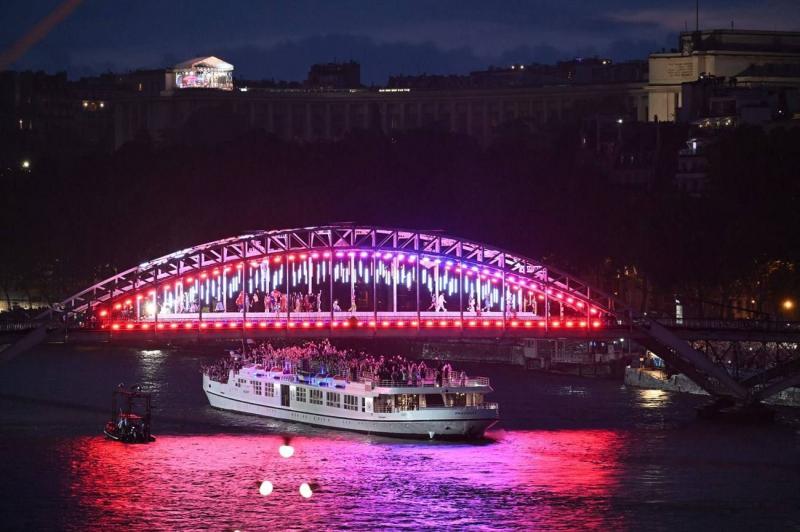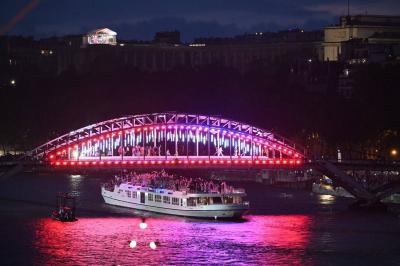The Olympic Games have returned to the City of Light, Paris, after a 100-year absence since it first hosted them in 1924. The opening ceremony of the Paris 2024 Olympics was a magnificent event that lasted 3 hours and 45 minutes, attended by French President Emmanuel Macron and leaders from most countries, with approximately 200,000 spectators watching from specially constructed stands along the riverbank, and many more viewing from the balconies of nearby buildings.
The ceremony featured various performances along the 6-kilometer stretch of the Seine River, which was transformed into a grand performance stage. Everything was arranged to create a historic and exceptional event, beginning with a fantastical sight of the Olympic torch's journey before arriving at the ceremony’s location on the Seine River.
Famous French football star Zinedine Zidane made a surprise appearance running through Paris in a pre-recorded video, carrying the torch in a malfunctioning subway, before handing it to children crossing the Seine in boats. The procession continued before the cauldron was ignited in an innovative manner.
A fleet of boats carrying 6,800 male and female athletes was present near some of Paris's most famous landmarks. The first boat carried the Greek delegation, the cradle of the modern Olympics, followed by others, including from the UAE.
Two thousand artists (dancers, musicians, comic actors, and acrobats) performed along the riverbanks and at tourist sites, including the Notre Dame Cathedral, which suffered significant damage from a massive fire in 2019, with a restoration laboratory highlighted in one of the ceremony segments.
The event featured artists dressed as construction workers dancing and clinging to scaffolding at the reconstruction site of the cathedral, which is set to reopen on December 8.
The opening festivities began with the motto "Let’s kick off the Games with a stunning show," which the organizing committee for the Paris Olympics embraced from the outset. The artistic and athletic display was grand and diverse, taking place over four hours along the banks of the Seine, undisturbed by the rain showers that fell for much of the time.
The invitation was directed to the entire world, encouraging everyone to experience unique emotions together: introducing trends of modernity and daring to the Games by bringing sports out of their usual venues and creating moments shared by as many people as possible. For the first time, before a very large gathering of "more than 300,000" spectators, including officials led by President Macron, several kings and queens, and the head of the International Olympic Committee, the opening ceremony was liberated from the main stadium and took place in the heart of the host city, Paris, with the Seine River as the main decoration.
The traditional course of the ceremony was altered: the performances and the athletes' parade combined with the protocol speeches in a ceremony that blended sport with art. For the first time, hundreds of thousands of spectators were allowed to participate, most attending for free, aiming to help make the opening ceremony the greatest show on earth in terms of generosity and popularity.
From the Austerlitz Bridge to the Trocadéro, athletes from all over the world paraded through Paris from east to west, gathering around their national flag bearers during an unprecedented 6-kilometer promenade on 85 boats and ferries adorned with bright colors.
Athletes captured the spotlight amidst warm applause from crowds lining the riverbanks, as they explored the exceptional venues of the Games that will host their competitions, such as the Invalides Park (athletics, archery, road cycling) and the Grand Palais (fencing, taekwondo) and the Eiffel Tower (beach volleyball).
They showcased the exceptional heritage of France and its capital, highlighted by Paris 2024, during this celebratory display, as they passed by many historical monuments, as though traveling through the history of France.
The event opened with a scene featuring Moroccan-French comedian Jamel Debbouze carrying the Olympic torch, heading toward a large stadium, but was surprised to find it empty of spectators.
While attempting to grasp what had happened, Zinedine Zidane, the French football star of Algerian descent, arrived, took the torch from him, and ran with it through the streets and squares of Paris, as children on skateboards and BMX bikes tried to catch up to take a photo but he entered a subway station, bought a ticket, and boarded a train, leaving the three disappointed children behind.
Suddenly, the train stopped, and the lights went out, prompting the children to catch up and retrieve the torch from him through a window. They walked along the riverbank, where a crocodile nearly devoured them, before a masked man covered in a boat on the Seine grabbed the torch and took them with him toward the Trocadéro square, where the arrival of delegations on boats began, starting with Greece and ending with France.
A juggler took the audience on an eventful journey through the most beautiful sites in Paris by climbing buildings and showcasing the capital's historical landmarks, especially Notre Dame and the Louvre, all in 12 artistic tableaux that featured a message of living together and the desire for "us to come together in peace, respect, and diversity."
The show was beautifully stylized by director Thomas Jolly, showcasing the diversity and vibrancy of French artistic scenery: choreographers, composers, costume designers, circus artists, and both emerging and internationally recognized talents came together to merge different eras, records, styles, and forms of art, engaging in a dialogue of France's multicultural heritage and the latest forms of artistic expression.
One of the bridges was transformed into a giant fashion show stage, complete with a red carpet and a black-and-white checkered floor.
The ceremony included many musical performances, highlighted by American singer Lady Gaga and French-Malian artist Aya Nakamura, before wrapping up with Canadian singer Celine Dion, who had been absent from concerts since 2020, singing Edith Piaf's "Hymne à l'amour" from the first level of the Eiffel Tower, defying her rare illness that hinders her singing career.
The scene concluded with a spectacular surprise, where the masked man met Zidane at the Trocadéro and handed the torch to Spanish tennis player Rafael Nadal, a fourteen-time champion of the French Open, breaking records.
But the surprises didn't stop there. "The Matador" boarded a boat alongside other stars, including Americans Carl Lewis and Serena Williams and Romanian Nadia Comaneci.
After a short ride, they handed the torch to former French star Amélie Mauresmo and then to Tony Parker, before several stars from handball, triathlon, and Paralympic sports took turns carrying it until it reached retired runner Marie-Josée Pérec and judo champion Teddy Riner, who lit the Olympic cauldron amidst a stunning light show at the Eiffel Tower.
The Olympic cauldron took the form of a balloon that soared above the city.




